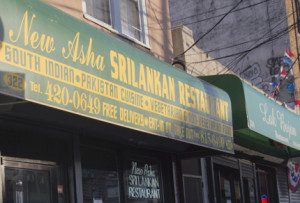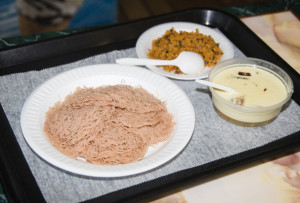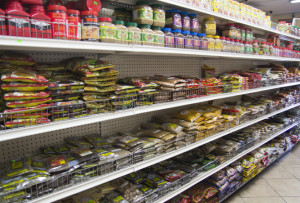Oh, hi there. In food writing class I bravely volunteered to take on Staten Island Borough for my beat and write about what I found for NY Table. What a great class we had!
While out reporting like a good little journalist (call me April O’Neil. Please. No but really, I like it a lot) I found something very pleasing to the tastebuds. Authentic Sri Lankan food. The real-deal dishes, styrofoam plates, plastic utensils, spiciness galore. Bliss.
I ate so much to make this possible and share my secret discovery in an article for NYTable: Sri Lanka.
P.S. It isn’t blogging if I’m aggregating my own published work.
P.S.S. I do what I want.
Love, April
______________________________________________________
Don’t come for the ambiance, but stick around for the food; Staten Island’s Little Sri Lanka.
By Amanda Burrill
In Staten Island’s small Tompkinsville neighborhood, a 25-minute walk or 10-minute bus ride from the Staten Island Ferry Terminal, is Little Sri Lanka, three restaurants and two grocery stores where Sri Lankan immigrants find their traditional dishes and ingredients alongside people who have heard of the area and come to try something new.
“Actually a lot of my customers, other than Sri Lankans who live in this neighborhood, come from far,” says Viji Devadas, who is the head chef at New Asha Sri Lanka Restaurant, owned by her brother, and located near the intersection of Victory Boulevard and Cobra Avenue. “Some are just visiting New York City. Tourists from all over the world stop in. It’s something interesting to try.”
But other than Sri Lankans, the restaurant doesn’t see many Staten Island residents.

This is the only borough with a non-Hispanic white majority, 66 percent. Of those, 35 percent are Italian and 15 percent are Irish, and Devadas can’t recall encountering either of those ethnic groups in her restaurant.
Some lifelong Staten Island residents aren’t even aware of Little Sri Lanka. “I’ve never heard of it,” said 20-year-old Italian-American Savino Cristo, who lives in an Italian neighborhood just two miles away, “and I’ve lived here my whole life.
“I came to the U.S. in 1986 and lived in Queens,” says Devadas, who now lives near the center of Little Sri Lanka. “But we opened the restaurant in 2000 so I moved here.”
Over 5,000 Sri Lankans reside in Staten Island now, making it the largest population outside of Sri Lanka itself. Those who immigrated here before the civil war started in 1983 were primarily educated professionals — doctors, engineers, and accountants — who could afford property and large homes on Staten Island. Those homes became useful landing pads for other family members as they came to the U.S. Once working class Sri Lankans started escaping the civil war in greater numbers, and after the war ended in 2009, they had a logical place to go.
Many who initially moved to other boroughs eventually found their way to Staten Island, much like Devadas, who says cooking the cuisine of Sri Lanka keeps her close to home: “I feel very happy, like I’m cooking for my family.”
Sri Lanka, formerly known as Ceylon, is the teardrop-shaped country off the southeastern coast of India. The country’s cuisine was clearly influenced by South India but made unique by spices brought in by foreign traders over centuries of serving as one of the world’s great trade hubs. Even Sri Lankans who didn’t settle on Staten Island come for the food.
“I call and make an order for string hoppers every Sunday,” says Ganga Costa, 48, who drives in from New Jersey almost every weekend. “Then I come pick them up in my car. These ones are better than ones I can get in New Jersey,” she says, lingering to chat with Devadas.
A typical hopper, or “appam,” is usually served for breakfast or dinner and made from a fermented batter of rice flour, coconut milk and palm toddy, a mildly alcoholic drink made from palm tree sap. Yeast sometimes serves as a palm toddy substitute. After the batter rises it is cooked in a small half-sphere pan. The finished hopper resembles a pancake cup, an edible vessel that tastes of mild sourdough and gets filled with an egg, chopped vegetables, fruit, curry, or all of the above.
String hoppers, or “idiappam,” are made from a rice flour dough rather than batter, which is pushed though a press or sieve to create small piles of noodles that are steamed until they bind together to form a web-like cake. The string hoppers are served with a side dish of coconut broth and sambol, a sauce comparable to Americans’ ketchup in that it can go with virtually anything. The most popular version of sambol, which is served with the string hoppers, is made by grinding coconut, chili peppers, dried Maldive fish and lime juice. “First you pour the coconut broth and sambol over the hoppers,” Costa instructs. “Then you break it up with your spoon and eat it like cereal.”

As string hoppers are more labor intensive, they are known as a Sunday special, along with a spicy dish called chicken devil.
“We are open seven days a week, but the weekends are busiest,” says Devadas, adding, “We don’t make beef or pork though. We are Hindu and Buddhist friendly, and kosher.”
Raj Haren, a 47-year-old teacher who emigrated from Sri Lanka to New Jersey, brings his family to New Asha at least one Sunday a month. His daughter Nila, 14, has known Devadas since she was three years old. “The food is authentic. I went to Sri Lanka once so I know,” she says. “I like the mutton rolls.”
His wife, Mythely, a 43-year-old physician, adds, “We started coming in 2003. It’s like visiting family.”
Across the street, Dosa Garden offers both authentic Indian and Sri Lankan cuisine, including tikka masala, a South Indian staple. “There is not a huge difference,” says Eesan Kesavan, 37, the owner, “I’d say we are 75 percent South Indian food and 25 percent Sri Lankan. But they overlap.”
Sri Lankan versions of any dish tend to be spicier. The unofficial national dish of Sri Lanka is rice and curry and the Staten Island restaurants offer an array, usually a main curry containing a protein — fish, chicken, pork or goat — served alongside smaller side curries made with vegetables or lentils. There are many different Sri Lankan curries, and it’s rare to see an actual recipe; the only thing they have in common is spiciness and heat. Also very popular is roti, which looks like a crepe and flatbread hybrid folded around a small amount of meat and vegetables, for lunch or dinner, or fruit and melted chocolate, for dessert.
Lak Bojun opened two doors south of New Asha in 2008 and specializes in lamprai, an homage to Sri Lanka’s Dutch colonial influences. Rice cooked in a curry-infused stock is piled on a banana leaf and topped with roasted eggplant, plantain, cashews and chopped frikkadels, the Dutch version of meatballs, then wrapped and baked. Often lamprai are topped with a deep-fried hard-boiled egg.
There are two grocery stores, each called Lanka Grocery, in the neighborhood. The original, on the western side of Victory Boulevard, opened 10 years ago and outgrew itself, necessitating the purchase of the large space across the street, now open for three years. The shelves are lined with spices in all the colors of the rainbow, lentils, other staples and a huge assortment of candles and incense.

All of the establishments help to keep an immigrant cuisine alive. New Asha’s authentic dishes, the small space with 12 dinner chairs distributed at three rectangular tables, and the warmth of Chef Devadas reflect the commitment to a family atmosphere.
“I don’t have silver and gold utensils here. This is simple in the mom-and-pop style,” says Devadas. “I love my job and I love what I do. Nice people come here.”
Tags: Sri Lanka, Sri Lankan Cuisine, Staten Island




 Share On Facebook
Share On Facebook Tweet It
Tweet It



